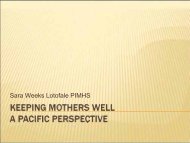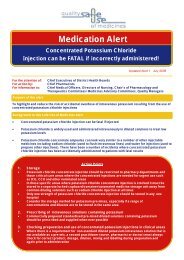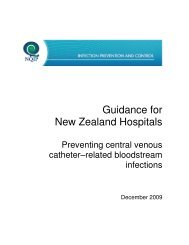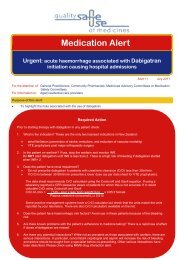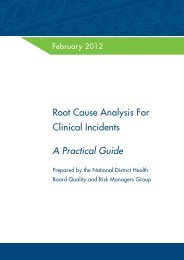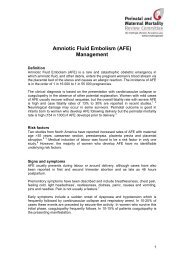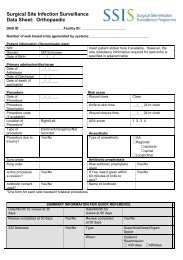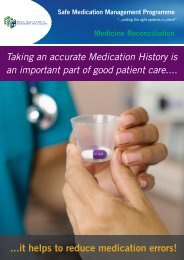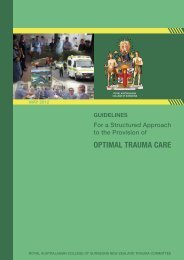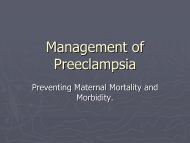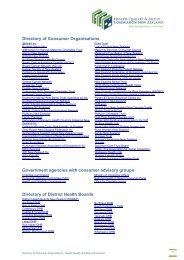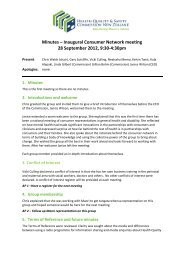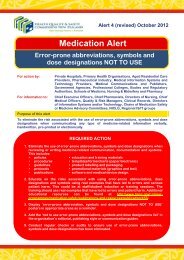Medicine Reconciliation The Process - Hqsc.govt.nz
Medicine Reconciliation The Process - Hqsc.govt.nz
Medicine Reconciliation The Process - Hqsc.govt.nz
Create successful ePaper yourself
Turn your PDF publications into a flip-book with our unique Google optimized e-Paper software.
National Medication Safety Programme<br />
<strong>Medicine</strong><br />
<strong>Reconciliation</strong><br />
<strong>The</strong> <strong>Process</strong>
Learning Objectives<br />
After this session, you will be able to:<br />
1. describe the three key steps in the process<br />
2. explain the difference between unintentional<br />
and intentional discrepancy<br />
3. define reconciled and unreconciled<br />
medicine
Background<br />
• Changes to patients’ medicines often happen<br />
during transitions of care<br />
• Some changes are unintentional due to poor<br />
information<br />
• Some changes are intentional but not clearly<br />
documented<br />
• Both types of change can result in medication<br />
errors and/or patient harm<br />
• <strong>Medicine</strong> reconciliation is an evidence-based<br />
process demonstrated to significantly reduce<br />
these types of medication errors
Did you know<br />
• Between 10 and 67 percent of medication<br />
histories have at least one error 1<br />
• Up to one-third of these errors have the<br />
potential to cause patient harm 2<br />
• More than 50 percent of medication errors<br />
occur at transitions of care 3<br />
References<br />
1. Tam VC, Knowles SR, Cornish PL, et al. 2005. Frequency, type and clinical importance of medication<br />
history errors at admission to hospital: a systematic review. CMAJ 173(5): 510-5.<br />
2. Cornish PL, Knowles SR, Marchesano R, et al. 2005. Archives of Internal <strong>Medicine</strong> 165: 424 -9.<br />
3. Sullivan C, Gleason KM, Rooney D, et al. 2005. Medication reconciliation in the acute care setting:<br />
opportunity and challenge for nursing. Journal of Nursing Care Quality 20: 95-98.
Principles<br />
Goal<br />
• <strong>Process</strong> completed for all patients within 24<br />
hours of transfer of care<br />
Impact<br />
• Reduce all discrepancies with potential to<br />
become medication errors or cause harm to<br />
patients<br />
Outcome<br />
• Patients receive correct medicines (ie, right<br />
medicine, in right dose, to right patient, by<br />
right route, at right time)
<strong>Process</strong><br />
Health practitioner performs three key steps:<br />
1. collects the ‘most accurate’ medicines,<br />
allergies and ADRs list<br />
• using at least two different information sources<br />
covering a period of at least 6 weeks<br />
2. compares the ‘most accurate’ list against<br />
prescribed information to identify any<br />
differences<br />
• any difference found not documented in the<br />
clinical notes even if clinically indicated are called<br />
a discrepancy<br />
3. communicates any discrepancies to the<br />
prescriber for reconciliation
Definition of a Discrepancy<br />
Any difference found between:<br />
• collected most accurate list during the<br />
medicine reconciliation process<br />
AND<br />
• prescribed medicines, allergies and<br />
ADRs e.g. on medication chart, within GP<br />
system<br />
that is not documented e.g. in patient’s clinical<br />
notes even if clinically appropriate = discrepancy
Allergies and ADRs<br />
• Reference made to ‘collecting’ rather than<br />
‘reconciling’ allergy and ADR information as<br />
unable to verify quality of allergy and ADR<br />
information<br />
• As allergy and ADR information is unable to<br />
be reconciled, reference made to<br />
‘difference’ rather than ‘discrepancy’ eg,<br />
allergy and ADR differences found presented<br />
to prescriber for an appropriate clinical<br />
decision and documentation
Intentional versus Unintentional<br />
Discrepancy can be:<br />
• intentional (ie, deliberate decision by<br />
prescriber at time of prescribing)<br />
• unintentional (ie, unaware or unknown to<br />
prescriber at time of prescribing)
Common Types of Discrepancies<br />
• Omission eg, inhalers, eye drops<br />
• Substitution eg, on terazosin but prescribed<br />
doxazosin<br />
• Alteration of dose, route or frequency eg,<br />
on metoprolol CR 47.5mg daily but prescribed<br />
metoprolol CR 95mg daily<br />
• Addition (commission) eg, omeprazole 40mg<br />
daily<br />
• Duplication eg, simvastatin and atorvastatin<br />
prescribed together from old list
Key point about Discrepancies<br />
• A difference found not accounted for ie, no<br />
documented communication of prescriber’s<br />
intention = discrepancy
<strong>Process</strong> Sign Off<br />
Can occur three ways:<br />
1. no differences identified<br />
• <strong>Process</strong> signed off by health practitioner<br />
undertaking medicine reconciliation<br />
2. differences identified and clearly<br />
documented<br />
• <strong>Process</strong> signed off by health practitioner<br />
undertaking medicine reconciliation<br />
3. differences identified but not documented =<br />
discrepancies<br />
• <strong>Process</strong> signed off by prescriber after they have<br />
reconciled discrepancies
Communicating Discrepancies<br />
Dependent on organisation:<br />
• prescriber notified that action required to<br />
reconcile discrepancies found<br />
• where reconciliation is urgent, prescriber<br />
contacted directly to discuss and rectify<br />
situation
Reconciling Discrepancies<br />
Within 24 hours, prescriber should:<br />
• reconcile individually by indicating whether<br />
discrepancy is:<br />
– unintentional<br />
– intentional<br />
• sign, date and time to indicate reconciliation<br />
completed for each discrepancy<br />
• update relevant patient records eg,<br />
medication chart, discharge summary, clinical<br />
notes
Summary<br />
• Three step process (collect, compare,<br />
communicate)<br />
• Differences become discrepancies if there is<br />
no documented explanation even if<br />
clinically indicated<br />
• Action undertaken to reconcile discrepancy<br />
within 24 hours of transfer of care<br />
• Prescriber identifies each discrepancy as<br />
unintentional or intentional<br />
• Each discrepancy must have documented<br />
time, date and signature for accountability



